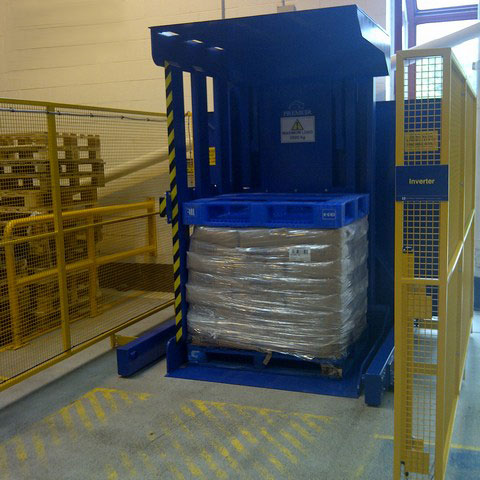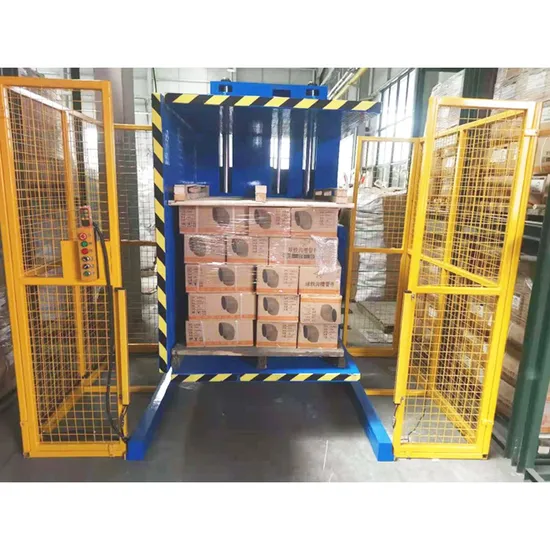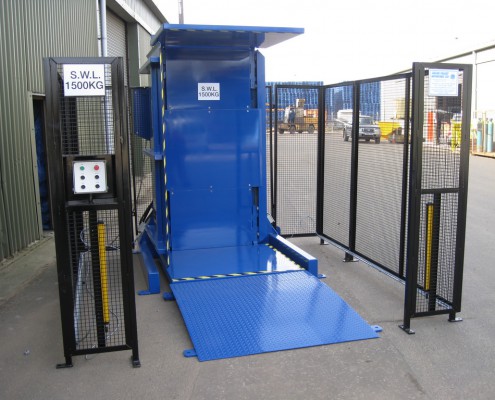Is Your Germany Factory Struggling with Precision Automation in Lean Manufacturing Plants? Try a Pallet Changing Machine
Are you running a lean manufacturing plant in Germany? You invest heavily in precision automation. You work hard to make every process efficient. But you still face bottlenecks that slow down your entire line. These delays often come from a simple, overlooked task: moving goods from one pallet to another. This manual process is slow. It's a risk for your products and your people. It feels like an old problem holding back your modern factory. It costs you money and efficiency every single day.
A pallet changing machine, also known as a pallet inverter, is a direct solution for German factories struggling with precision automation in lean manufacturing. This equipment automates the transfer of goods between pallets. It eliminates the need for manual restacking. This immediately boosts speed, reduces labor costs, and protects products from damage. It integrates smoothly into automated lines, removing a critical bottleneck and allowing your entire system to operate at its full potential.

I understand the pressure you are under. As an engineer who built my own packing machine factory, I've faced similar challenges. I remember watching my highly advanced production lines wait for simple manual tasks to be completed. It was frustrating. You have invested in state-of-the-art robotics and control systems. You expect a seamless flow. But a small, manual step can disrupt everything. Let’s explore how a specific piece of equipment, the pallet changer, can solve this problem. It’s not just a machine. It is a key to unlocking the full efficiency you have worked so hard to build.
How can a pallet changing machine reduce operational costs in a high-wage economy like Germany?
Your factory in Germany operates in a high-wage environment. Every minute of labor is a significant cost. You might see your team spending valuable time manually unloading and restacking goods from a wooden pallet to a plastic one for your cleanroom. This process is not just slow; it's expensive and full of risks. Every time a person handles a product, there's a chance of dropping it, damaging it, or causing a workplace injury. These small, hidden costs add up quickly and eat into your profits.
A pallet changing machine directly cuts operational costs by automating manual labor, preventing product damage, and speeding up your entire logistics process. Instead of paying multiple workers to spend hours on this task, a single operator can use a machine to transfer a full pallet load in under a minute. This drastically reduces your labor expenses. It also minimizes the risk of costly product damage and workplace accidents, which leads to lower insurance premiums and less waste.

Breaking Down the Cost Savings
Let's look closer at the numbers. Running a factory in Germany means dealing with some of the highest operational standards and costs in the world. You are always looking for an edge. A pallet changing machine provides a clear and measurable return on investment. It's not just about doing things faster; it's about doing them smarter and cheaper.
I remember a client in the food and beverage industry. Their facility was a model of lean manufacturing. But they had a persistent problem at the receiving dock. Incoming ingredients arrived on various quality wooden pallets. Their internal hygiene standards required everything to be moved to sanitized plastic pallets. This created a huge bottleneck. A team of four workers spent their entire shift just restacking bags and boxes. The cost was enormous, not just in salaries but also in the occasional burst sack or crushed box. After installing a pallet inverter, one operator managed the entire process. The bottleneck disappeared. Their direct labor costs for that single task dropped by over 75%.
Three Pillars of Cost Reduction
We can group the savings into three main areas: Labor, Product Protection, and Operational Efficiency.
-
Labor Savings: This is the most obvious benefit. Manual pallet handling is labor-intensive. In a high-wage economy like Germany's, this is a major expense. By automating the process, you can reassign skilled workers to more value-added tasks instead of simple manual labor.
-
Product Protection: Manual handling leads to mistakes. Products get dropped, dented, or contaminated. A pallet changer handles the entire load securely and gently. This significantly reduces waste and the costs associated with damaged goods, customer complaints, and returns.
-
Operational Efficiency: Time is money. A manual pallet transfer can take 15-30 minutes. A pallet changing machine does it in about one minute. This speed increase eliminates delays, keeps production lines moving, and allows for higher throughput. It directly supports the core principles of lean manufacturing by removing waste from your process.
Here is a simple table to illustrate the potential impact:
| Cost Factor | Manual Process (Before) | Automated Process (After) | Annual Savings Example (per machine) |
|---|---|---|---|
| Labor | 2 workers x 4 hours/day @ €30/hour | 1 operator x 0.5 hours/day @ €30/hour | > €50,000 |
| Product Damage | 1% of goods damaged annually (e.g., €20,000 value) | <0.1% of goods damaged annually (e.g., <€2,000 value) | > €18,000 |
| Throughput Speed | 20 minutes per pallet | 1 minute per pallet | Increased capacity, reduced overtime |
| Workplace Safety | Higher risk of back injuries, strains | Minimal manual handling, lower risk of injury | Lower insurance premiums, less downtime |
These are not just abstract numbers. They represent real money that goes back to your bottom line. For a pragmatic business owner, an investment must have a clear and justifiable return. The pallet changing machine offers exactly that.
Can pallet changers truly integrate with aging equipment for a digital transformation?
You have a factory with equipment that has served you well for over 15 years. It’s reliable, but it wasn't built for today’s digital world. Now, you’re pushing for a digital transformation. You want to deploy MES, IoT sensors, and data analytics. But you worry that these new systems won't be able to communicate with your older machinery. It feels like you have to choose between keeping your trusted equipment or embracing the future. This is a common challenge for established steel mills and manufacturing plants.
Yes, modern pallet changers are designed for integration and can bridge the gap between your aging equipment and your digital goals. They are not just standalone machines. They come with modern PLCs (Programmable Logic Controllers) that can be programmed to communicate with older and newer systems. They can be fitted with sensors that feed data directly into your MES or IoT platforms. This allows you to add a fully automated, data-rich process step into a production line that was previously a "black box."

Connecting the Past to the Future
Digital transformation isn't about replacing everything at once. That's too expensive and disruptive. The smart approach, the one I’ve always favored in my own factory, is to upgrade strategically. You identify the key bottlenecks and data gaps, then you deploy modern solutions to solve those specific problems. A pallet changing machine is a perfect example of this strategy in action. It’s a targeted investment that brings modern automation and data connectivity to a critical point in your production flow.
Let’s think about how this works in a practical sense. Your 15-year-old wrapping machine might be a workhorse, but it doesn't tell you much. You don't know exactly when a pallet is ready, how long it waits, or when it moves to the next stage. This is a major gap in your production data.
The Integration Blueprint
Now, imagine placing an automated pallet changer right after that wrapping machine. Here’s how it helps your digital transformation:
-
Creating a Digital Handshake: The pallet changer can be equipped with sensors. An optical sensor detects when a wrapped pallet arrives from the old machine. This sends a signal: "Pallet Received." This is your first new data point. The changer performs its task. Another sensor confirms when the new pallet is ready to be picked up. This sends a second signal: "Task Complete, Pallet Ready."
-
Feeding the MES/ERP System: These simple "start" and "stop" signals are gold for your Manufacturing Execution System (MES). You now have precise timestamps for a key logistics step. Your MES can use this data to:
- Track the real-time status of every pallet.
- Calculate the exact throughput of your wrapping and packaging area.
- Identify and measure any downstream delays. If a pallet waits too long after being changed, your system can flag it.
-
Enabling Predictive Maintenance: The pallet changer itself is a source of valuable data. Modern machines can monitor their own hydraulic pressure, motor temperature, and cycle counts. This information can be sent to your central system. Instead of waiting for a breakdown, your maintenance team gets an alert when performance starts to change, allowing for predictive maintenance. You fix problems before they stop your production line.
Here is a table showing how a pallet changer acts as an integration hub:
| Feature | Connection to Aging Equipment | Connection to Digital Systems (MES/IoT) | Benefit for Your Factory |
|---|---|---|---|
| Infeed/Outfeed Sensors | Detects arrival of pallet from old machine via physical sensor. | Sends "Pallet Arrived" signal with timestamp to MES. | Creates a digital start point for the logistics process. |
| Modern PLC | Can be wired to the old machine’s simple start/stop controls. | Communicates detailed status (busy, idle, fault) via Ethernet. | Provides full visibility into the machine's operation. |
| Cycle Counter | Operates independently of the old equipment's age. | Transmits cycle count data to the IoT platform. | Enables precise tracking for predictive maintenance scheduling. |
| Safety Interlocks | Integrates into the existing safety circuit (E-stop). | Can send "Safety Circuit Tripped" alerts to maintenance phones. | Enhances safety and provides instant fault notification. |
By adding a pallet changer, you are not just automating a physical task. You are inserting a node of intelligence into your factory floor. You are making an old process visible, measurable, and controllable. This is a powerful, cost-effective step in your digital transformation journey.
What is the real ROI of investing in a pallet changer for a lean manufacturing plant?
As a practical business owner, you look at every investment through one main lens: Return on Investment (ROI). You need to know that the money you spend on new equipment will come back to you, and then some. A new machine might look impressive, but if it doesn't improve your bottom line, it's a liability. You’ve seen proposals for massive, complex automation projects with questionable payback periods. So, you are rightly skeptical. You want to see the real, hard numbers behind a pallet changer.
The real ROI of a pallet changer is excellent and typically realized within 12 to 24 months, driven by direct cost savings, increased throughput, and risk reduction. Unlike some large-scale automation, a pallet inverter is a focused investment that tackles a specific, high-cost problem. Its financial benefits are not theoretical; they are immediate and easy to calculate. The payback comes from cutting labor costs, eliminating product waste, and preventing costly production stoppages.

Beyond the Initial Price Tag
When I started my own factory, I had to be extremely careful with my capital. Every purchase had to justify itself. I learned to look beyond the initial purchase price and analyze the total impact on my operation. A pallet changer is a perfect case study for this approach. Its value isn't just in the machine itself, but in the problems it solves and the opportunities it creates.
Let's do a simplified ROI calculation. This is the kind of analysis I would do before making a decision for my own plant. We need to consider both the investment (the costs) and the return (the savings).
Calculating Your Return
The investment part is straightforward. It's the cost of the machine plus any installation and training fees. The return is where we need to be detailed. It's the sum of all the savings the machine generates over a year.
1. Investment (Costs):
- Pallet Changer Purchase Price: Let's estimate €30,000 for a standard model suitable for a German plant.
- Installation & Training: Let's add €5,000.
- Total Initial Investment: €35,000
2. Return (Annual Savings):
- Labor Savings: Imagine you replace a manual process that requires two workers for three hours a day.
- Labor Rate (including overheads) in Germany: ~€35/hour.
- Daily Cost: 2 workers 3 hours/day €35/hour = €210/day.
- Annual Cost (250 working days): €210 * 250 = €52,500.
- The new process needs one operator for maybe 20 minutes total per day. The savings are massive. Let's be conservative and say the annual labor saving is €48,000.
- Product Damage Reduction: If you handle €3,000,000 worth of product through this point annually, and the manual process has a 0.5% damage rate, that's €15,000 in lost product. The machine reduces this to near zero.
- Annual Savings from Damage Reduction: €14,000.
- Increased Throughput & Reduced Downtime: This is harder to quantify but very real. Eliminating a bottleneck might prevent 30 minutes of production line stoppage per week. What is that worth to you? Let's assign a conservative value.
- Annual Savings from Increased Efficiency: €10,000.
Now, let's put it together in a table:
| Financial Metric | Calculation | Value |
|---|---|---|
| Total Initial Investment | Machine Cost + Installation | €35,000 |
| Annual Labor Savings | (Manual Labor Cost) - (Automated Labor Cost) | €48,000 |
| Annual Damage Savings | (Manual Damage Cost) - (Automated Damage Cost) | €14,000 |
| Annual Efficiency Gains | Value of Increased Uptime and Throughput | €10,000 |
| Total Annual Savings | Sum of all savings | €72,000 |
| Payback Period | (Investment) / (Total Annual Savings) * 12 | 5.8 months |
| First-Year ROI | ((Total Savings - Investment) / Investment) * 100% | 105.7% |
This is a powerful result. Even with conservative estimates, the pallet changer pays for itself in less than six months and delivers a return of over 100% in the first year. This is the kind of clear, compelling business case that forward-thinking leaders look for. It's a strategic investment that strengthens the foundation of a lean, efficient, and profitable manufacturing operation.
My Insights
When I first started in this industry, I was an engineer on the factory floor. I saw waste every day. I saw brilliant, expensive machines sitting idle because of a simple, manual bottleneck somewhere else in the line. Later, when I founded SHJLPACK and had to manage my own finances, I understood the other side of the equation. As an owner, you feel the weight of every cost, from energy bills to payroll. You know that survival and growth depend on efficiency. This journey from engineer to owner is why I believe so strongly in finding practical, high-impact solutions.
You are not just looking for a machine supplier. Javier, you are looking for a strategic partner who understands your challenges: the pressure of energy costs, the reality of aging equipment, and the constant need to improve profitability. You need someone who can help you connect the dots between a piece of equipment and your larger goals of digitalization and cost reduction.
A pallet changing machine is more than just a way to flip a pallet. It is a strategic tool.
- For your goal of reducing operating costs: It directly attacks your highest expenses – labor and waste.
- For your goal of increasing capacity utilization: It removes a common bottleneck, allowing your entire production line to flow more smoothly and closer to its true potential.
- For your goal of digital transformation: It serves as a bridge, bringing modern data and control to your existing, older production lines.
I started SHJLPACK with a mission to share the knowledge I gained over decades in this business. I achieved my own success by focusing on solutions that provided a clear and rapid return on investment. I helped my clients grow by showing them how a targeted investment in packaging and handling automation could solve their biggest operational headaches.
My advice is to look at the pallet changer not as a cost, but as an investment in stability, efficiency, and future-readiness. It’s a practical step you can take right now to make your German factory more competitive and your operation more profitable. This is the kind of smart, targeted automation that builds a stronger, more resilient business. It’s a solution I would implement in my own factory without hesitation.

Conclusion
Investing in a pallet changing machine is a smart, strategic move to cut costs, boost efficiency, and advance the automation goals of any modern lean manufacturing plant.



